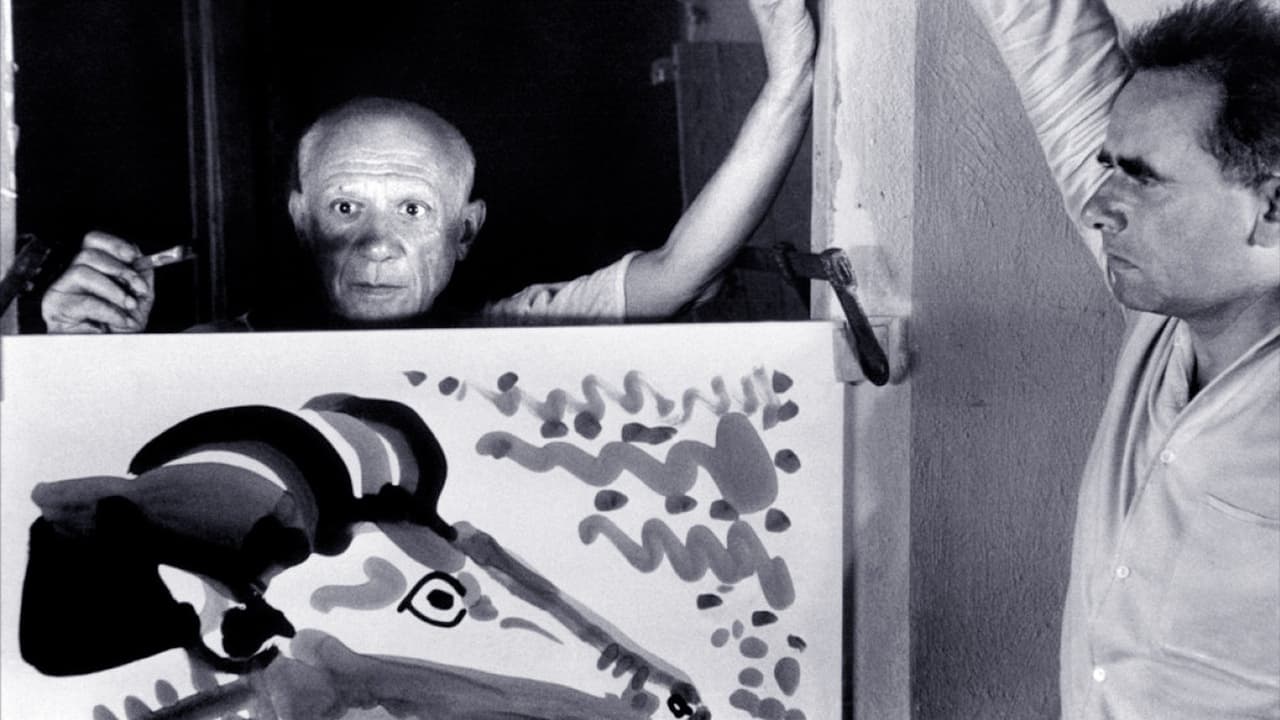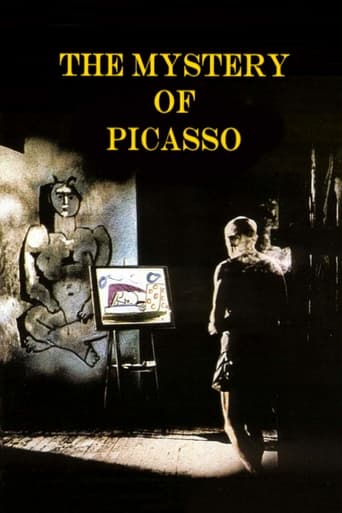

Picasso (at 75, typically vigorous and wearing only shorts) drew or painted with colored ink on stretched canvas or paper which Clouzot's cameraman photographed from the back to show the artist doing maybe 20 paintings as they unfold from a few lines to a piece bristling with shapes and color. The assumption behind this is a little naive as Michael Atkinson said six years ago in the Voice. Atkinson called it the "bourgeois" assumption that we can see into the mind of an artistic genius by watching him at work. Well, as some of the sequences show and as the old Art News series "So-and-So Paints a Picture" showed, actually you can learn quite a lot about how an artist works out his ideas by following the sequence -- especially if he makes a lot of changes, and it is fascinating to get that kind of inside look. A slight weakness of Clouzot's film is that the process is staged, and allegedly (some say it isn't true) the paintings were even destroyed after the film was made.Now, some of these pictures Picasso whipped off aren't particularly good. But Picasso worked fast normally. And as Motherwell once said, his unsuccessful paintings were necessary stepping-stones to the good ones. If you've looked at a lot of Picasso's work as I have, including the Skira suite of 180 drawings titled in the English edition "Picasso and the Human Comedy" of 1954,* which relates directly to some of the drawings done for the film, there won't be much "mystery" about the sequences--particularly as they relate to drawings. Toward the end though, Picasso starts doing some full-fledged paintings with overlays (I'm not at all sure how that was filmed, possibly by another method), where he really changes things all around multiple times (as he did with some of his etchings too--and looking at the sequence of them will give you very similar information). That's more like the abstract expressionists (De Kooning, for instance) memorably chronicled in the "........Paints a Picture" Art News articles, and such metamorphoses do show the genius of the man, if not really how it works, since we're looking at, not into. I think Atkinson calls Georges Auric's music "bombastic." I found it unnecessary and turned it off (though thereby missing some of the self-conscious narration and dialogue), and I also speeded up the painting sequences because I can think visually faster than this movie plods along. The self-importance of the project is not untypical of other Fifties coverage of super-famous artists and it's mildly grating, but though I waited a long time, this film had to be seen.*This book cost about $25 then. It is now worth a couple thousand dollars. Similarly the film has supposedly been declared a "national treasure" by the French. "Bourgeois" or "hagiographic" or self-important though it may be, this is an invaluable record..(Henri-Georges Clouzot, Le Mystère Picasso 1956. Netflix DVD. Not a particularly good one: minimal visual quality and the commentary would not open.)
... View MoreThis film is as visually pleasing as it is intellectually stimulating. Much as time-lapse photography reveals in seconds the weeks-long emergence, growth and blooming of a sprout into a flower, "The Mystery of Picasso" reveals the growth and evolution of several paintings. Each stage of each creation is a painting unto itself. To watch this film is quite literally to browse a metaphorical gallery of progressively different compositions. Quite often, the viewer may feel that Picasso has gone too far; that he should have rested his paint brush and walked away earlier than he did. Of course that comprises the intellectual weight of the film. When is an artist done? It is a question that writers, poets, painters, even film makers ponder. Imagine reading alternative, unpublished chapters of Gabriel Garcia Marquez; or imagine watching several varying, unedited director's cuts of a Luis Bunuel film. Henri-Georges Clouzot leaves his audience with an incredible appreciation for the dynamic, living, breathing process that goes into each Picasso canvas. Clouzot adds drama toward the end by informing Picasso that his film is running out. Is it really? The maestro doesn't seem to be rushed. Either that or he performs remarkably well under pressure.
... View MoreA fascinating look at the creative process, filmed in a unique fashion, using a clever technique to capture Picasso's work as he is painting without his hand or his brush getting in the way. This method is actually shown and explained during a live action sequence in the middle. Although the film is mostly just a set of different Picasso paintings in action, interactions between the film's director and Picasso are added in, which not only decreases tedium from the at times monotonous paintwork, but it also makes it a whole lot more interesting, as it feels as if we are there with Clouzot and Picasso in a film studio. The material still becomes a tad repetitive and it tires before the film is over, but set to some great music and actually showing Picasso working through his creative process, this is remarkable, one-of-a-kind film-making and definitely worth checking out.
... View MoreThis film reminds us that film is visual - very few words are spoken in Le Mystère Picasso. Instead, the camera just trains in canvas and white paper and watches Picasso create. It could have been boring, but instead it's hypnotic. One learns about the creative process without lecture!
... View More